It is quite easy for you to describe those things you see or hear. Yet generally, we have considerable difficulty in putting any name to a smell. We try to describe it by comparing it to some other smell; and tend to describe the feelings those aromas awaken in us. We refer to those smells we like as “nice” or pleasant, and to those we do not as “bad” or unpleasant, because a great many smells we encounter in our daily lives do not have actual names.
 |
What we refer to as a smell is actually a reaction to chemical particles—in other words, molecules—given off by an object. The origin of the smell of freshly ground coffee that you find so delightful is actually the floating airborne molecules emanating from it. The more of these are given off, the stronger the aroma. The reason why a baking cake smells so much more strongly than a stale one is because the cake in the oven is emitting so many more scent particles. Scent molecules begin moving in the air more freely under the effect of heat, and are able to disperse over a wide area. But be aware that delicate balances have been specially arranged for human life. There are materials such as stone, iron and glass around you that you cannot smell, because these substances do not vaporize at room temperature. But assume for a moment that everything in your room suddenly began giving off aromas: Can you imagine how disturbing and even life-changing that would be?
Another interesting fact is that although water vaporizes at room temperature and even below, it has no odor. This special feature in water is most important, since it means that there is no difference between the scent of a dried rose and one that has been freshly watered and still has droplets on its petals.
 |
| Or, Who has created the heavens and the earth, and Who sends you down rain from the sky? Yea, with it We cause to grow well-planted orchards full of beauty of delight: it is not in your power to cause the growth of the trees in them. (Can there be another) god besides Allah. Nay, they are a people who swerve from justice. Surat an-Naml: 60) |
In other words, the rose’s natural perfume is unimpaired. Furthermore, the water vapor, or moisture, in the air actually strengthens the effect of any existing smell. For instance, water molecules that vaporize after a downpour of rain raise scent particles up into the air and assist in spreading the scent of flowers all around.
 |
No one knows how many varieties of odors there are in nature. Bearing in mind the existence of millions of molecules, we may safely say that the variety of scents is enormous. Studies have been carried out to place these aromas into various categories. But due to the extraordinary variety of smells, no satisfactory classification has ever been achieved.1
The microscopic variation between molecules gives any one smell its particular characteristics. (Figure 1) For example, the feature that differentiates a cooked, fresh egg from a rotten one lies in the structures of the particles the two eggs give off. Differences in the chemical structures between various molecules are based, in turn, on very delicate variations.2
Indeed, the addition or subtraction of a single carbon atom can turn an attractive smell into a repellent one!
The design in every point in the universe can immediately be seen in the structures of scent molecules. The unique aromas of cocoa, lavender or strawberry are the results of the molecules that give rise to these smells, and to the specially arranged bonds among them. Every molecule has been planned in light of a specific purpose, in the exactly the form it needs to be. There is no doubt that this magnificent design belongs to God, "Who created everything and determined it most exactly" (Surat al-Furqan: 2).
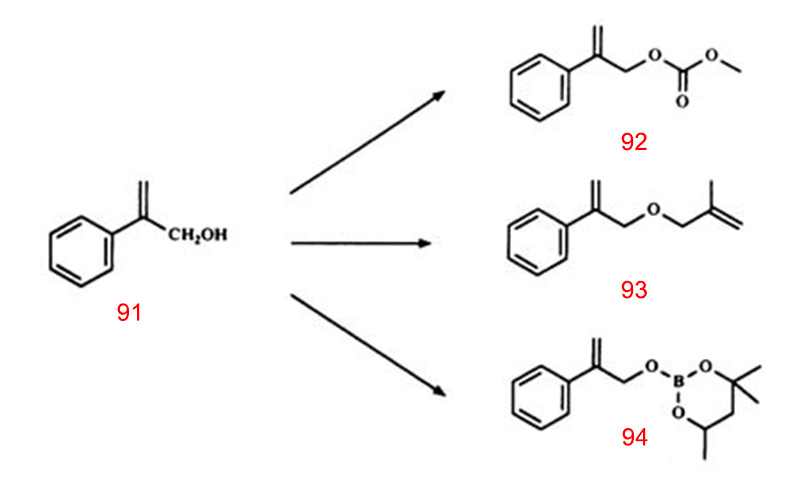 |
| (Figure 1) The three derivative scents of the chemical substance whose structure is shown in (91) resemble that of the rose. Yet each is distinguished from the other two by a different smell. The scents of lilac and spices (92), ozone and fruit (93) and cinnamon, carnation, spices and lilac all smell like the rose mixed with these scents. |
 |
| Very small differences between molecules cause flowers and fruits to have very different scents from one another. |
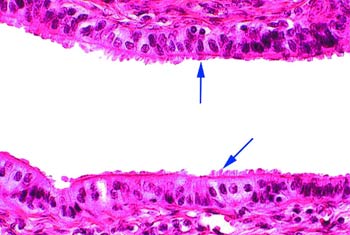 |
| (Figure 2) A photograph of the micro-hairs known as cilia taken under the microscope |
When the olfactory, or scent-perceiving, organ is mentioned, the nose immediately comes to mind. However, very few are aware that as little as 5% of the nose is actually involved in the perception of scents.3 Gordon Shepherd, professor of neuroscience at Yale University emphasized the truth of this when he wrote, "we think that we smell with our noses, [but] this is a little like saying that we hear with our ear lobes."4
The following pages shall examine that part of the nose concerned with scent perception. First, however, we should make a brief reference to the other 95%, which undertakes two major responsibilities on behalf of your respiratory system. The first of these is to warm and moisturize the air you inhale. The mucus layer covering the interior surface of the nose releases water vapor to moisture the air that enters. The large numbers of capillary vessels immediately beneath the mucus layer also warm the passing air, adapting it to the sensitive structure of the lungs. The mechanism in question resembles the air conditioning system that regulates the levels of temperature and humidity in buildings.
 |
The second important function of the nose is to halt dust particles, bacteria and germs, thus acting as a screen to diseases that might otherwise reach the lungs. This is how this splendid security system functions: Harmful particles that enter with the air are trapped by the mucus layer. Then tiny hairs known as cilia go into action. (Figure 2) They propel mucus containing harmful substances at a speed of 1 centimeter (0.4 inches) per minute toward the pharynx, where it is either expelled by coughing or else destroyed by gastric acids.
These processes, here described in general terms, are in fact so exceedingly complex that the details of the mechanism by which millions of micro-hairs operate as a single entity has still not been fully understood. The mucus layer, mucus-producing cells and micro-hairs comprise a perfect chemical purification plant that works so flawlessly that it immediately identifies what is essential to the body and what is dangerous to it, and takes the necessary actions.
One truth is very apparent here: The air-conditioning, security and purification mechanisms in the nose are all examples of perfect engineering. It cannot possibly be imagined that circulatory, respiratory and digestive system cells agreed to cooperate among themselves and draw up plans like engineers. It is also impossible for the systems in question to have come about as the result of coincidences and to produce the aesthetically pleasing human face. It is revealed in verses that God created everything, from the Earth to the skies, with its perfection of design:
... Everything in the heavens and Earth belongs to Him. Everything is obedient to Him, the Originator of the heavens and Earth. When He decides on something, He just says to it, 'Be!' And it is. (Surat al-Baqara: 116-117)
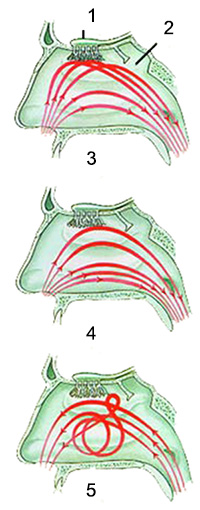 |
| 1. Olfactory bulb |
| (Figure 3) We breathe in and out through our noses all day long. Our noses adapt the air that enters it to the lungs in the finest way and direct part of that air to the olfactory region, and thus we perceive smells at the same time. |
You breathe an average of 23,040 times each day.5 During this constantly repeated process, your nose adapts air for the lungs in the most appropriate manner. In doing so, it performs another very important task: It detects and monitors odors.(Figure 3)
The total population of a sniff is a billion trillion molecules, nearly all of them normally in the mix we call air.6 The scent particles, far too small to be seen with the naked eye, are contained within this enormous quantity of molecules. After you have breathed in, special turbinate bones in the nose direct a portion of that air to the scent-perceiving region. In this way, scent molecules arrive at a region in the upper part of the nasal cavity, some 7 centimeters (2.756 inches) inside and above the nostrils. (Figure 4)When you lift a flower to your nose and smell its perfume, a great number of molecules reach the scent-perception region.
Most people are unaware that they possess such an extraordinary chemical-analysis facility that lies within the scent-perception region, works non-stop to analyze odors in the surrounding area. As you go about your daily life, making no special effort to perceive smells, this facility is in action nonetheless. Even when you sleep at night, it perceives potentially harmful smells such as smoke and warns you. This facility is so utterly perfect that it is able to determine more than 10,000 different odors7, functioning with a perfect accuracy and sensitivity.
The small scent molecules that form the basis of aromas come in different shapes and sizes.8 The breathtaking scents in a garden, the attractive aromas of a delicious meal, or the repellent stench of rotting fruit all arise from different molecules. The chemical plant in your nose is easily able to identify all these different molecules, and can even immediately distinguish molecules with the same atomic formulae. For example, the minute difference between the molecules L-carvone and D-carvone stems from their atoms having different sequences. Despite this exceedingly close similarity, a human nose can easily distinguish between the two, telling us that the former suggests cumin and the latter, spearmint.9
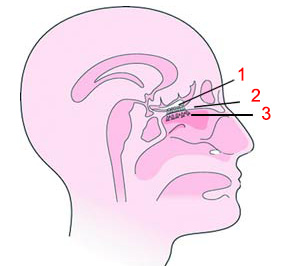 |
| 1. Olfactory bulb |
| (Figure 4) The figure shows the olfactory region to which is directed part of the air we inhale. |
Another property of the nose that amazes scientists is its immaculate sensitivity. The minimum concentration of a substance required for us to recognize its particular smell is known as the smell threshold. The analysis mechanism in our noses in unbelievably sensitive; some scents in the air can be perceived at concentrations of less than one part in a trillion! Research has shown, for example, that the threshold for perception of butyric acid is a 10 billion fold dilution of the pure substance.10
The more molecules are investigated, the more marvels of the scent perception system are revealed. What we perceive as any single aroma is actually an effect caused by large numbers of different molecules. For instance, the “ordinary” smell of white bread actually consists of around 70 different scent molecules. It is estimated that the smell of coffee results from a combination of at least 150 different chemical substances.11 A top-quality perfume may contain 500 ingredients.12
The analysis mechanism in your nose identifies these chemical substances at very low concentrations, without your being aware of it. All these processes that take place between your detecting a smell and concluding that it belongs to coffee brewing, take place in much less than a second. Bearing all this in mind, the superior creation in the scent perception mechanism can doubtless be better appreciated.
God reveals in one verse that:
"And in your creation and all the creatures He has spread about there are Signs for people with certainty." (Surat al-Jathiyya: 4)
 |
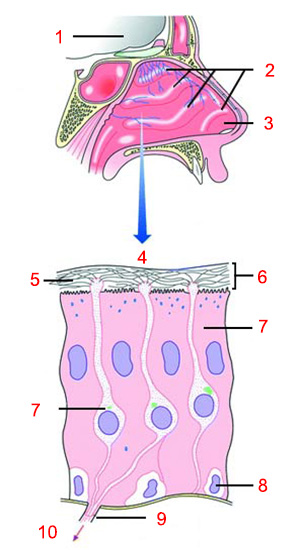 | |
| 1. Brain | 6. Mucus |
| (Figure 5) Thanks to the flawless internal structure of the nose as seen in the figure, we are able to perceive scent molecules reaching us from the outside. | |
As you sat watching television, were someone to tell you that the broadcast came, not from any television station, but as the result of electromagnetic waves forming at random in the air and that the television had not been produced in a factory but had come into being spontaneously over the years from the atoms and molecules in your home, what would you think?
You would probably imagine that person was joking. Certainly you would not take his words seriously. When you realized that they were actually serious in making that claim, you would conclude they had lost their reason. That is because in that example, we are dealing with a technological design: A television set is a device specially manufactured with the aim of receiving televised broadcasts. In short, both the television and the broadcasts—and every aspect of the relationship between the two—have been planned down to the finest detail.
In this complex system, there is absolutely no room for chance.
Yet evolutionists maintain something even more irrational. The view of Darwin and his evolutionist followers may be summarized as follows: According to their logic, the scent perception mechanism—far more highly advanced than television broadcast technology and which is still not yet fully understood—and the flawless harmony between the countless scent molecules and the nose, came into being as the result of so-called coincidences. (Figure 5) To put it another way, atoms randomly combined to form molecules that make up the different aromas on Earth and at the same time, those same molecules spontaneously brought the nose into being, the organ which is capable of identifying them all separately and of interpreting what it perceives. There is allegedly no plan, design or intellect involved here. According to evolutionists, everything happened over billions of years by means of unconscious, uncontrolled and random events that, all combining together, eventually gave rise to any number of perfectly flawless systems.
 |
Anyone with a little reason and common sense can immediately see the flaws in this evolutionist logic. The subjects described in later chapters of this book will fully reveal the errors that evolutionists make regarding these matters. No doubt the structure in the nose has been specially created to perceive odors, and is a yet another sign of the omniscience of God, its Creator. Every detail you will learn throughout these pages represents a proof of this flawless design and perfect creation.
Indeed, in the Qur'an God has revealed this harmony and flawlessness that can be seen everywhere on Earth:
He Who created the seven heavens in layers. You will not find any flaw in the creation of the All-Merciful. Look again—do you see any gaps? Then look again and again. Your sight will return to you dazzled and exhausted! (Surat al-Mulk: 3-4)
You wake up in the morning to delightful aromas emanating from the kitchen. Even as you think to yourself, How good that smells, you are unaware of all the processes going on inside your nose. But just what is happening in your nasal cells at that moment?
Scientists have been trying to answer this question for many years, but have still failed to fully unravel how the scent- perception cells recognize particles in the air. What they do know goes no further than theory. Indeed, less is known about scent perception than about our other senses.13
At present, one of the most widely accepted theories, first proposed by R.W. Moncrieff, is known as the steric theory, according to which, scent particles come in different shapes and sizes, and combine with receptors unique to them in the olfactory region. The relationship between the receptors and the scent particles is comparable to that between a lock and a key. In the same way that a lock can be opened only by a particular key, so scent receptors go into action as a result of the effect of certain molecules only.
 |
| O ye who believe! Eat of the good things that We have provided for you, and be grateful to Allah, if it is Him ye worship. (Surat al-Baqara: 172) |
John E. Amoore developed this theory further, and determined seven main smells, which he termed ether, camphor, musk, flower, mint, sharp and rotten. He then proposed that all scents consist of combinations of these seven “building block” odors.14
Another scientist, Luca Turin, proposed the vibration theory of olfaction, maintaining that scent receptors in the nose work like a spectroscope, a device used to measure vibration frequencies, and that they identify molecular vibrations. According to Turin, receptors in the nose are apparently designed to be compatible with the vibration frequencies of scent molecules. This resembles the way in which special cells in the retina of the eye are created to be compatible with specific wavelengths of light. Turin thinks that at the basis of scent perception, there is a complex mechanism based on electron transfer. 15
Other theories include J.T. Davies and F.H. Taylor’s diffusion pore theory, G. M. Dyson’s molecular vibration theory and B. Rosenberg’s piezo effect theory. 16
In short, we still do not know how the communication between scent molecules and scent receptors takes place. In other words, the perceptive processes that take place in the receptor cells in our noses have not yet been fully unraveled.
Obviously, however, there is, considerable speculation, and in the following pages, we will devote more space to one view that has gained wider acceptance in comparison to the others.
Laboratories equipped with the very latest devices permit all kinds of scientific research to be carried out. Yet that we still do not understand how our sense of smell works once again shows the perfection of the system in question and the overall creation of human beings.
As science unravels the details in the human sensory systems, it lays out the facts for all to see.
The sensory organs are the work of a flawless design, and have been created with a delicate equilibrium calculated to be ideal for healthy human life.
Another observation that emerges is how thoroughly mistaken is the theory of evolution, which maintains that life is the work of chance.
 |
| God, the infinitely compassionate, gives human beings their ability to detect smells and creates pleasant aromas. |
Your senses provide you with enormous amounts of information about the outside world. We may not always be aware that our senses play a vitally important role in our perception of what’s going on around us. When you close your eyes and smell dinner cooking in the kitchen, you can unfailingly identify what is on the menu.
By scent alone, you can tell whether or not the dinner is cooked, or whether something in the refrigerator has spoiled. We can also identify a great many environments, such as hospitals, restaurants, markets, schools or our own homes, from their odors alone.
Your capacity to detect smells is much greater than you imagine. Some researchers even say that it would be a mistake to reduce this capacity to a numerical figure, since our sense of smell is able to distinguish between countless different odors.17
Let us now look more closely at the marvels of creation that make up this supremely competent and highly accomplished system.
Two olfactory regions (Regio olfactoria) are located in the roof of the two nasal cavities of the human nose, just below and between the eyes. (Figure 6) The region occupies 2.5 square centimeters (0.39 square inches) and is covered in mucus secretions. Mucus is a sticky fluid secreted by Bowman’s glands. The mucus layer covering the olfactory region is about 0.06 millimeter (0.023 of an inch) thick.18 If this layer were even slightly thicker, your capacity to perceive smells would decline considerably. The reason why your ability to perceive smell decreases when you catch a cold is because mucus production is increased. If the thickness of the mucus were any less, then your body’s immune system will be weakened and the olfactory micro-hairs in the mucus layers could easily be damaged.
The basic functions of mucus have been known for some time. Among other things, it prevents drying inside the nose and constitutes a defense against foreign chemical substances. But only recently was it realized that mucus has a most organized structure and constitutes a most ideal environment.19 Indeed, it is a very rich mixture of proteins, enzymes, mucopolysaccharides, immunoglobulins and lipids.
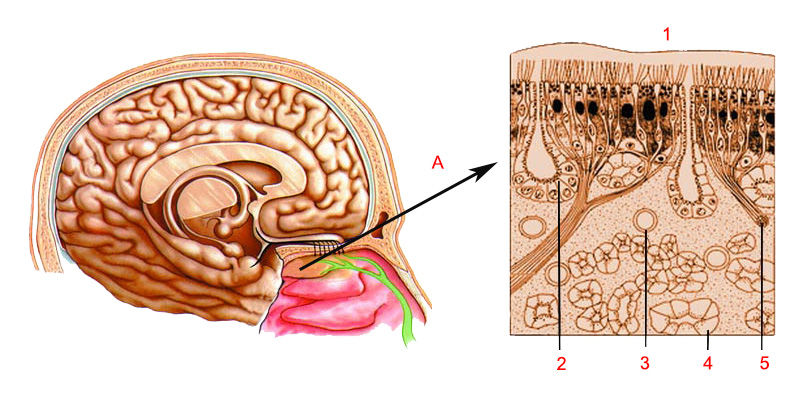 | |
| A. Olfactory region (Regio olfactoria) | 3. Blood vessel |
| (Figure 6) The cellular organization of the olfactory region | |
The first stage in olfactory perception begins in the mucus layer. In order for scent particles contact the receptors in the micro-hairs, they must first pass through this stratum. At this stage, special connection proteins in the mucus layer combine with scent particles and serve them literally as guides.20 These proteins are still the subject of research. They are thought to assist scent particles and receptors to come together and also prevent excessive numbers of scent molecules from reaching the receptors.21 What is certain is that the proteins recognize thousands of different scent particles, establish communication with them and regulate the molecular traffic in the mucus layer—reaffirming the fact of an astonishing creation.
Imagine yourself wandering in a garden filled with lovely-smelling flowers and holding them up to your nose to smell them, one by one. In order for new scent particles to reach the receptors in your nose, the old molecules need to be disposed of, or it will be impossible for you to detect the smell of the second flower after smelling the first. Such an eventuality could have unwelcome consequences, but it is prevented by certain enzymes within the mucus.22
 |
| And the herbs and the trees - both (alike) bow in adoration. (Surah ar-Rahman: 6) |
To describe it in simplified terms, after a specific—but quite brief—length of time, the enzymes in question alter the structures of the scent particles and convert them to a state where they no longer stimulate the receptors. Later, these neutralized molecules are sent to the stomach together with the mucus that traps them, and are thus eliminated. Note that it is not expert biochemical engineers and scientists who accomplish this, but enzymes with no mind or consciousness. In addition, the enzymes in the mucus achieve this by constantly making new “decisions.” Naturally, enzymes cannot manage such complicated tasks all by themselves. All this takes place through the limitless knowledge and magnificent creation of God.
In conclusion, there is an astonishing activity in the depths of the mucus layer that manages the scent-perceiving region in your nose. Countless processes, of which you are unaware and cannot see with the naked eye, proceed with perfect planning and timing.
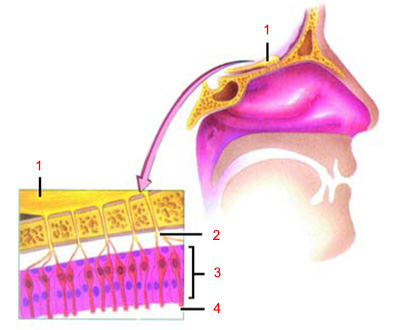 | |
| 2. Olfactory bulb | 3. Cell body |
| (Figure 8) The olfactory cell is made up of three main sections; the cell body in the middle, the micro-hairs known at cilia at one end and an extension known as the axon at the other end. There are between 15 and 20 million scent cells in the nose. Each one survives for about a month and is then replaced by others. | |
Scent receptors are actually nerve cells whose main function is to carry to the olfactory bulb the messages triggered by scent molecules. Views in the scientific world differ as to their numbers. Some researchers put the figure at 10 million23 , and others at around 50 million.24 Millions of scent cells in the olfactory region—which is no larger than the smallest postage stamp—are arranged in an astonishing regularity. If you possessed all technical means and were asked to place millions of cells in exactly the right locations, could you do it? Such a task would of course be impossible.
After all their years of research, scientists have been unable even to determine the exact number of cells, let alone set out millions of them, showing that this task is of course impossible.
Within the scent cell itself, there is also a striking division of labor. As the well-known researcher Stuart Firestein points out: "The olfactory system accomplishes its sensory tasks with biological mechanisms that are common to many signaling systems."25 This special design quickly manifests itself in drawings prepared from electron microscopy images. (Figure 7)
The olfactory cell consists of three main sections, the cell body in the middle, the micro-hairs known as cilia at one end, and a protrusion known as the axon at the other. (Figure 8) The cell body is where many complex activities take place, the cilia where contact is made with scent molecules, and the axon where electrical signals are transmitted.
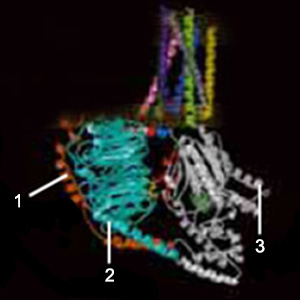 | ||
| 1.Gamma Unit | 2. Alpha Unit | 3. Beta Unit |
| (Figure 9) The structure of a scent receptor. The structure consisting of seven spirals, in the upper part of the diagram, is the section on the receptor cell membrane. The units at the bottom of the diagram constitute the part remaining inside the cell. | ||
The number of micro-hairs at the end of the cell ranges between 10 and 30, and their lengths between 0.1 and 0.15 millimeters (0.0039 to 0.006 inch).26 The difference between these scent hairs and similar ones in other regions of the nose is that the former move and possess scent receptors. (Figure 9) In contrast to the other cilia in the body, the olfactory micro-hairs are entirely independent structures. They assume the role of a skeleton for the receptors. Close inspection shows the most productive design for the micro-hairs, with a wide area for contact between scent molecules and receptors being squeezed into a very small region. In addition, latest research has revealed that each olfactory cell contains just one of a thousand different types of scent receptor,27 as we'll consider later, in greater detail.
Though the term cilia or micro-hairs may suggest very simple structures, the fact is that these terms describe only the shape of the structures in question. In fact, olfactory micro-hairs possess an incomparable and extraordinary communications technology. Scent molecules that dissolve in the mucus combine with special receptors on the scent micro-hairs.
The relationship between the scent molecule and the receptor resembles that between a lock and key. As a result of molecular details that have not yet been fully clarified, a signal is formed within the scent-receptor cell. At this stage, a great many proteins and enzymes unfailingly discharge the responsibilities placed upon them.
The process by which scent-receptors turn the characteristics of scent molecules into electrical signals is rather complicated. At present, only two of the communication networks in the scent-receptor cells are known. In the very simplest of terms, the communication can be summarized as follows:
Let us first examine the communication established by means of cAMP (adenosine 3',5'-cyclic monophosphate). (Figure 10)
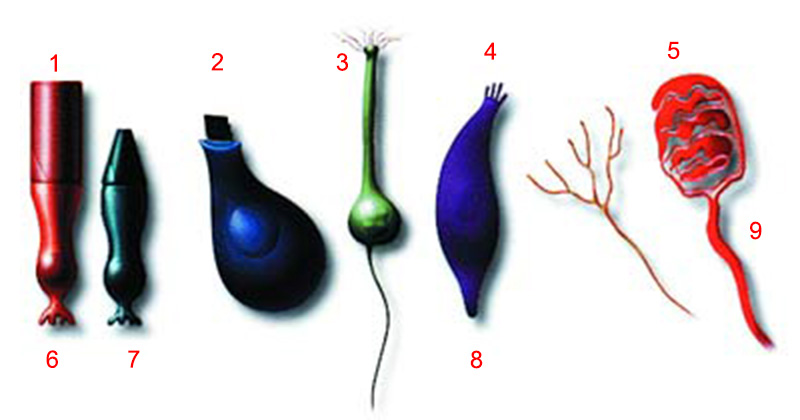 | |||
| 1. Sight | 4. Taste | 6. Rod | 8. Free nerve endings |
| (Figure 7) Some cells in the sensory systems. As we can see, each sense cell has a special design. | |||
When scent molecules combine with the receptors, a rapid sequence of processes begins within the scent receptor cell. First, the G-old protein is brought to an active state and sets the enzyme AC into action. AC accelerates the transformation of ATP in the cell into cAMP—a messenger bound to the channel that joins the cilia to the cell membrane.
This results in the channels opening up and calcium ions entering the cilia. Entry of the calcium ions causes the chloride channels to open, and chloride ions leave the cilia. In this way, a cell with an initial negative charge becomes without charge and an electrical signal forms as a result of this series of chemical reactions, moving along the cell axon to reach the olfactory bulb.
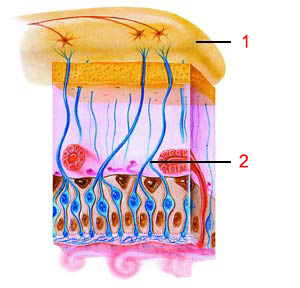 | |
| 1. Olfactory Bulb | 2. Axon |
| (Figure 11) The electrical signal, created in the scent cells as a result of various chemical reactions, reaches the olfactory bulb by moving along the axon. | |
Some scent molecules do not affect the level of cAMP, but instead raise the concentration of IP3 (inositol 1,4,5-Triphosphate), which initiates the process that releases the electrical signal in the cell. The stages of the chain reaction of this cellular communication line have not yet been fully understood.28 However, the communication within these minute cells is clearly the product of an astonishing design.
While all this is taking place at one end of the olfactory cells, astonishing processes are occurring in the axons at the other end. The axon carries the signal emerging in the cell to the olfactory bulb in the anterior region of the brain. (Figure 11) In order to reach the bulb, neuronal cells form axons that are bundled in groups of 10-100 to penetrate the ethmoidal cribriform plate,29 whose porous structure allows the olfactory nerves to pass through it.
The design in this part of the skull is just one factor that enables you to perceive odors. Otherwise it would be impossible for the nerves to establish communications with one another, and thus to transmit olfactory signal. If all the necessary elements comprising the olfactory system were present, but nerves’ passage through the bone was impeded, then you would be unable to smell. No doubt, every detail in this system is wholly indispensable.
To summarize these facts in a single sentence: The flawless communication in the olfactory cell is the result of special design, and that design is just one of the countless proofs of the splendor in creation.
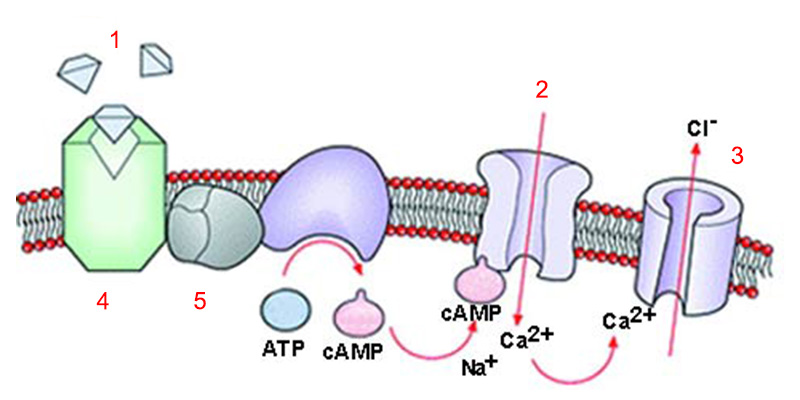 | |
| 1. Scent Molecule | 4. Receptor |
| (Figure 10) The main stages of the cAMP communication line that forms in the cell when the scent molecule bonds to the scent receptor. | |
The olfactory bulb is located in the anterior region of the brain, immediately above the olfactory region and the skull. (Figure 12) There are two bulbs, corresponding to the two olfactory regions, each about the size of a pea. Despite their small size, however, they may be compared to a giant communications center in terms of the tasks they perform. All the signals from the scent receptors are first collected in this center. Millions of units of data are re-ordered and then sent for interpretation by means of special scent nerves to the scent cortex, hippocampus, amygdala and hypothalamus in the brain. (Figure 13) The olfactory bulb, which is tiny is where flawless coordination between the millions of olfactory cells takes place. Examine the communication in the bulb in a little more detail, and you can see why this coordination center is so incomparable.
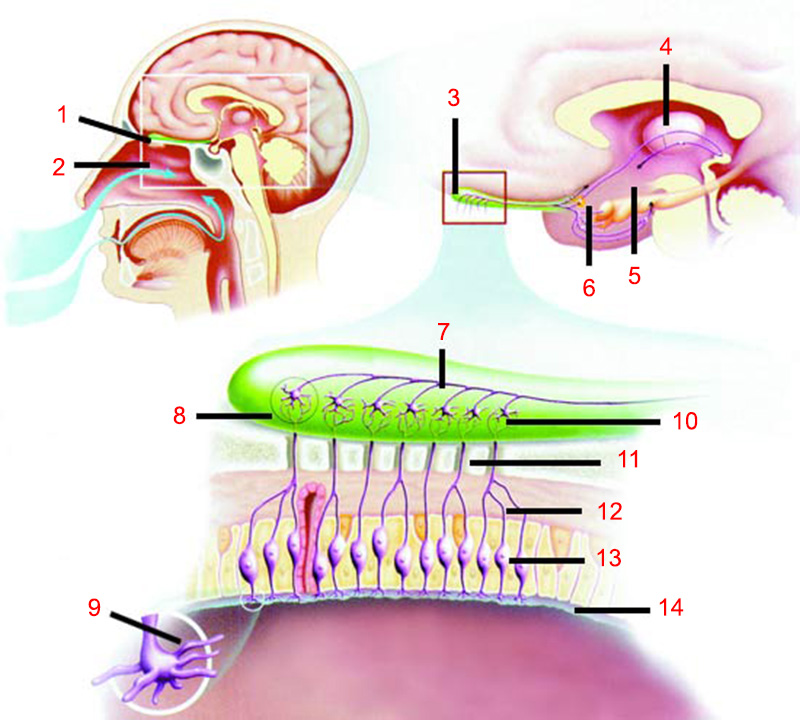 | |
| 1. Olfactory Bulb | 8. Scent Nerve Fibers |
| (Figures 12-13) The olfactory bulb's location in the skull, and details of its structure | |
The scent-receptor cells bring the signals to the bulb. The mitral cells, which number around 50,000 in an adult human, carry the messages they receive from the bulb to the brain. Communication between the two groups is effected by communication units known as glomerules in the bulb. Remember, this spherical communication unit is just 0.1 millimeter (0.004 inch) in diameter.30 There are around 2,000 glomerules in a single olfactory bulb. Every glomerulus contains up to 25,000 scent receptor cell axons, and up to 25 mitral cell dendrites.31
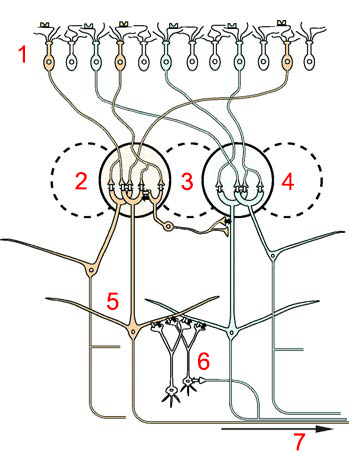 |
| 1. Scent Cells |
| (Figure 14) The creation in the olfactory bulb is exceedingly complex. The diagram to the side shows just two scent cells (brown and blue) with different receptors, two glomeruli and a few cells. Remember, there are tens of millions of scent cells, thousands of different scent receptors, 2,000 glomeruli, and tens of thousands of mitral cells, massed cells, granule cells and periglomerular cells in the scentperception system. When all this is borne in mind, the complexity involved can be better understood. |
When we consider these figures as a whole, the most astonishing numbers emerge: Messages from millions of scent cells are transmitted to tens of thousands of mitral cells.(Figure 14) Millions of units of information are thus exchanged between cells in intervals as short as a few thousandths of a second, and in a flawless manner. (No space is devoted to the marvels of communications in the neurons here. For more detail on this subject see, Harun Yahya, The Miracle of Hormones, New Delhi: Goodword Books) In addition, the information from every receptor is collected in the bulb, rearranged and organized to further increase scent sensitivity—in other words, a more perfect result is obtained than existed before. 32
For an analogy of this error-free communication, assume that specific information is carried along million telephone lines, and that at a switchboard, the number of these lines is suddenly reduced to a thousand. In such an event, it is impossible that there will be no loss of the original information or errors in its transmission. It is not possible to prevent it, even using advanced technology. However, scent cells continue to perform the same function, in a flawless manner, throughout your life. The message transportation in the bulb is the product of an amazing creation.
Recent research has revealed a great many marvels of design in the olfactory bulb. The connections established by olfactory cells with the communication units in the bulb take place with an enormous order and regularity. The glomerulus to which every scent receptor cell will transmit is predetermined, so that signals from the same kind of receptor meet at a particular glomerulus. Each one of the millions of olfactory cells, from different areas of the olfactory region, come to one of some two thousand glomerules.33 (Figure 15) The common view of the researchers who discovered this is that data from the different receptors is installed in an exceedingly organized manner.34 Each one out of millions of cells finds exactly the right one out of two thousand alternatives—which once again shatters all the claims of evolutionists who try to ascribe complexity to sheer chance.
Other cells in the olfactory bulb are periglomerular and granular cells, which go into action when the flow of messages needs to be halted, and are thought to play a preventive role.35 So complex are the control mechanisms here that the system is still not yet fully understood.
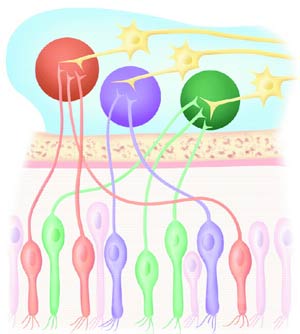 |
| (Figure 15) A simplified representation of the exceedingly complex communications in the olfactory bulb. This diagram depicts just three of the 1,000 different types of scent-receptor cells (blue, green and brown) and the connections they establish with the mitral cells (yellow) in their own specific communication units (in the glomerulus). |
Imagine the telephone network in a large city with millions of inhabitants. Could such a network, to which millions of phones are interconnected, have come into being by itself? Could the centers or switchboards, to which the phones are linked, have come into existence by chance? Even if all the raw materials were collected together in a field and one waited for millions of years, would it be possible for the flawless communications network in question to form spontaneously—as evolutionists claim?
The answers are evident. No matter how long you wait, not a single phone will emerge, let alone a whole urban telephone network. That is because a telephone network is the product of design and engineering, and must be planned and arranged with delicate measurements and calculations. Any other explanation is mere nonsense. In the same way, it is utterly nonsensical to try to account for the olfactory bulb’s complex structure in terms of coincidences.
That not the slightest confusion is allowed to arise during communications in the olfactory bulb is an astonishing evidence of creation. It is God, the Lord of the worlds, Who brought this immaculate system into being, with all its many details, as a blessing for human beings. Nothing remains to be said about those who maintain the opposite, who ascribe the perfect design in this system to blind, uncontrolled coincidences, because the fact of creation, and all the evidence, is plain for all to see. Anyone who makes such claims must have an atrophied conscience, have lost the use of logic and reason, and be preconditioned not to accept the facts.
It is revealed in the Qur’an that the faithful addressed people with that same mindset in these terms:
"... Do you then disbelieve in Him Who created you from dust, then from a drop of sperm, and then formed you as a man? He is, however, God, my Lord, and I will not associate anyone with my Lord." (Surat al-Kahf: 37-38)
 |
| Our ability to distinguish the various pleasant smells of foods, flowers and drinks is a blessing bestowed on human beings by God. |
In the 1990s, researchers established that there are around 1,000 different olfactory receptors in our noses.36 This astonished scientists, because the variety of receptors in the scent-perception system was many times greater than that in the visual, hearing and taste systems. Moreover, another question was added to the already long list of those to which the answers were unknown: How can we detect more than 10,000 different scents with only 1,000 different receptors?
In 1999, American and Japanese scientists researching this question obtained significant findings about the olfactory system’s functioning. According to the results of that research, a scent receptor is able to establish bonds with various scent molecules, which sends a number of scent receptors into action.37 Continued studies revealed the presence of a very special mechanism in the olfactory system. In the words of Linda B. Buck, one of the researchers in question, this mechanism was a special “alphabet.”38
As you know, the words and sentences we use consist of letters. For example, the English language alphabet we use to communicate contains 26 letters, which mean nothing on their own. A significant meaning emerges only when they are combined in a specific sequence.
Similarly, an alphabet consisting of receptors is used in the olfactory system. To put it another way, 1,000 different receptors represent 1,000 different “letters.” There is no specific receptor responding to every smell in our olfactory region; instead, different scent molecules stimulate specific receptors, which then set specific glomerules in the olfactory bulb into action. This forms a special combination, or code, for the scent. For example, scent A activates communication units 23, 246, 456, and 799 in the olfactory bulb, while scent B does the same for numbers 382, 573, 684, 812 and 1245. These two different codes are then perceived as different smells in the brain’s scent cortex. A quick mathematical calculation shows that this mechanism we possess can identify millions of different aromas.39
The reason why the sentence “The kitchen smells of vanilla” has meaning is that the letters in our alphabet are set out in a particular sequence. Similarly, an aroma from the kitchen expressing “vanilla” takes place by means of receptors and glomerules being stimulated in a particular manner. 39
 |
| (Figure 16) With the exception of chromosome 20 and the Y chromosome, there are scentreceptor genes in all human chromosomes. The richest chromosome, in terms of scent receptor genes, is chromosome 11. |
The brain’s scent perception region analyzes the signals from different receptors en masse. The smell which we define as one single perception occurs as the product of 1,000 different receptors. In other words, every receptor is actually part of a mosaic, and a perceptible scent emerges only once all the components of the mosaic have been assembled.
Professor John C. Leffingwell compares the way that receptors give rise to perceptions of smell in the brain to the way that letters in particular combinations form words, notes form works of music, or a binary code gives rise to computer programs.40 Like every new scientific finding, of course, this discovery represents a major disappointment for evolutionists. It is impossible for a play of Shakespeare’s to emerge by chance from letters, or for a work by Mozart to arise from an assembly of notes. It is also impossible for smells to emerge by chance from the olfactory system’s “alphabet,” which is incomparably more complex. Even the word impossible fails to do justice to its scale.
Therefore, even if evolutionists believe that scent receptors formed by chance, that still does not release them from the quandary in which they find themselves, because these receptors are controlled by some 1,000 genes.41 To express it even more clearly, scent receptors are produced in the light of a pattern previously encoded in the genes. And scent-receptor genes are distributed throughout all the chromosomes, apart from chromosome 20 and the Y chromosome.42 (Figure 16) It is impossible for the genetic coding for a single scent receptor form spontaneously, or as the result of chance. If all the rational, conscious humans who lived prior to the 20th century, and were therefore ignorant of how a computer works, were collected together, they could still never write an ordinary computer program. That being so, can one really expect blind, unconscious atoms to write the genetic codes for receptors to perceive the aromas of flowers, fruits and countless chemical substances?
Absolutely not! Scent receptors and perception systems, olfactory cells, and the genes that control them cannot exist in the absence of a Creator Who made them. That Creator is God, "The Lord of the heavens and the Earth and everything between them".(Surat ash-Shu'ara': 24)
 |
One very important property distinguishes olfactory nerve cells from other neurons. Although the hundred billion or so neurons in the brain cannot be replaced as long as we live, the millions of scent receptor cells in the nose live for an average of 45 days. Those that die at the end of that period are replaced by others.43 The site where new olfactory cells arise is among the basal cells in the olfactory region. Basal cells work literally like a scent-cell factory, constantly and regularly producing new ones.
Under some circumstances, when a heavy blow is received to the head—in a traffic accident, for instance—olfactory cells may be compressed in the ethmoid bone, one of those making up the skull. If the damage is not too great, new cells take over, thus preventing any loss of scent perception. This re-acquisition of the sense of smell has been observed in a great many cases.44
How do the new cells unfailingly know where to install themselves? How do they reach their objectives in the olfactory region? How are new receptors able to maintain the communication established by their predecessors with scent molecules, with no loss or error occurring? How is communication between the receptors and the olfactory bulb re-established, with no deficiency or error?
 |
The world of science keenly awaits answers to these and similar questions.45 What is known at present is the existence of astonishing mechanisms among the cells, the details of which are not known. Even though roughly a million olfactory cells are completely replaced every 45 days, you still perceive the smell of a rose as belonging to a rose. Were any error in the exchange of duties in the olfactory cells to take place, then you would identify a great many scents wrongly, or else be totally unaware of them and be unable to rectify any confusion that would arise. Your olfactory system would constantly mislead you and give rise to serious difficulties. Yet nothing of the sort ever happens. New nerve cells faultlessly take over the functions of the old ones.
Another rather astonishing point is how those new olfactory nerves unerringly find their way to the olfactory bulb. There are no signposts in the nose or brain, and new cells can hardly ask directions. Yet the connections within the olfactory nerves are constantly renewed throughout your life, in such a way as to leave no room for error. This cannot be explained in terms of probability calculations. To claim that the bonds among millions of olfactory nerves came into being by chance is like asserting that the cables constituting the telephone system of a major city were unerringly laid out by the wind, lightning and random coincidences.
 |
No doubt, these are all proofs of the flawless creation and matchless artistry of our Almighty Lord. Every part of the olfactory system, every cell, every molecule and every atom, all behave in the manner inspired in them by Omniscient and Almighty God, ever since the day they were first created. God instructs them how to behave at every moment, right down to the finest detail. This truth is revealed in a verse of the Qur'an:
It is God Who created the seven heavens and of the Earth the same number, the Command descending down through all of them, so that you might know that God has power over all things and that God encompasses all things in His knowledge. (Surat at-Talaq: 12
1. P.M. Wise, M.J. Olsson, W.S. Cain, "Quantification of Odor Quality", Chemical Senses 25, New York: Oxford University Press, 2000, pp. 429-443. ![]()
2. Chastrette, "Trends in structure–odor relationships", SAR QSAR Environ. Res. 6, 1997, pp. 215-254. ![]()
3. P. Whitfield, D.M. Stoddard, Hearing, Taste, and Smell; Pathways of Perception, New York: Torstar Books, Inc., 1984. (http://www.macalester.edu/~psych/whathap/UBNRP/Smell/nasal.html) The Olfactory System: Anatomy and Physiology, Macalester College, 2001. ![]()
4. Maya Pines, "Finding the Odorant Receptors", Howard Hughes Medical Institute, 2001, http://www.hhmi.org/senses/d/d120.htm. ![]()
5. Diane Ackerman, A Natural History of Senses, New York: Vintage Books, 1995, p.6. ![]()
6. Philip Morrison, “The Silicon Gourmet,” Scientific American, April 1997, p.92. ![]()
7. Stuart J. Firestein, “Olfactory Receptor Neurons,” Encyclopedia of Life Sciences, December 2000, http://www.els.net. ![]()
8. Heinz Breer, “Olfaction,” Encyclopedia of Life Sciences, August 1999, http://www.els.net. ![]()
11. Britannica CD 2000 Deluxe Edition, Chemoreception: Process of Olfaction. ![]()
12. Diane Ackerman, Op. cit., p.46. ![]()
13. “Research Uncovers Details Of How Sense Of Smell Works,” Science Daily Magazine, 1998, http://www.sciencedaily.com/releases/1998/01/980112064707.htm ![]()
14. John E. Amoore, Molecular Basis of Odor, Springfield: C.C. Thomas, Pub., 1970. http://www.leffingwell.com/olfact4.htm ![]()
15. Luca Turin, “A Spectroscopic mechanism for primary olfactory reception,” Chemical Senses 21, 1996, pp. 773-791. ![]()
http://www.leffingwell.com/olfact4.htm
16. Tim Jacob, “Olfaction,” 2001, http://www.cf.ac.uk/biosi/staff/jacob/teaching/sensory/olfact1.html. ![]()
17. G. Ohloff, Scent and Fragrances, Springer-Verlag, Berlin Heidelberg, 1994, p.6. ![]()
18. John C. Leffingwell, Op. cit., http://www.leffingwell.com/olfaction.htm. ![]()
19. P. Whitfield, D.M. Stoddard, Hearing, Taste, and Smell: Pathways of Perception, New York: Torstar Books, Inc., 1984. (http://www.macalester.edu/~psych/whathap/UBNRP/Smell/nasal.html) The Olfactory System: Anatomy and Physiology, Macalester College, 2001. ![]()
20. http://chemse.oxfordjournals.org/cgi/content/abstract/15/2/217 ![]()
21. John C. Leffingwell, Olfaction-Page 2: The Odorant Binding Proteins, 2001, http://www.leffingwell.com/olfact2.htm. ![]()
22. A. Chess, I. Simon, H. Cedar, and R. Axel, “Allelic inactivation regulates olfactory receptor gene expression,” Cell 78, 1994, pp. 823-834. ![]()
23. Stuart J. Firestein, Op.cit., http://www.els.net. ![]()
24. John C. Leffingwell, "Olfaction", 2001, http://www.leffingwell.com/olfaction.htm. ![]()
25. Stuart J. Firestein, Op.cit., http://www.els.net. ![]()
26. Eric Chudler, “Brain Facts and Figures,” 2001,
http://faculty.washington.edu/chudler/facts.html. ![]()
27. B. Malnic, J. Hirono, T. Sato, an L. Buck, “Combinatorial receptor codes for odors,” Cell 96, 5 March 1999, pp. 713-723. ![]()
28. Heinz Breer, Op.cit., http://www.els.net. ![]()
29. John C. Leffingwell, Op.cit., http://www.leffingwell.com/olfaction.htm. ![]()
30. Kensaku Mori, Hiroshi Nagao, Yoshihiro Yoshihara, “The Olfactory Bulb: Coding and Processing of Odor Molecule Information,” Science 286, 22 October 1999, pp. 711-715. ![]()
31. Tim Jacob, Olfaction, 2001, http://www.cf.ac.uk/biosi/staff/jacob/teaching/sensory/olfact1.html. ![]()
33. P. Mombaerts, F. Wang, C. Dulac, S.K. Chao, A. Nemes, M. Mendelsohn, J. Edmondson, R. Axel, “Visualizing an olfactory sensory map,” Cell 87, 15 November 1996, pp.675-686. ![]()
34. “Sensing Smell,” Howard Hughes Medical Institute Annual Report, 1999, http://www.hhmi.org/annual99/a243.html. ![]()
35. Tim Jacob, “Olfaction,” 2001, http://www.cf.ac.uk/biosi/staff/jacob/teaching/sensory/olfact1.html. ![]()
36. Linda B. Buck, Richard Axel. “A novel multigene family may encode odorant receptors: A molecular basis for odor recognition,” Cell 65, 1991, pp.175-187; R. Axel, “The Molecular Logic of Smell,” Scientific American, October 1995, pp.154-159. ![]()
37. B. Malnic, J. Hirono, T. Sato, and L. Buck, “Combinatorial receptor codes for odors,” Cell 96, 5 March 1999, pp.713-723. ![]()
38. “Researchers Discover How Mammals Distinguish Different Odors,” Howard Hughes Medical Institute News, 1999, http://www.hhmi.org/news/buck.html. ![]()
39. “The Sense Of Smell,” 3 April 2000, http://www.edc.com/~jkimball/BiologyPages/O/Olfaction.html. ![]()
40. John C. Leffingwell, “Olfaction-Page 5: Recent Events in Olfactory Understanding,” 2002, http://www.leffingwell.com/olfact5.htm. ![]()
41. Richard Axel, “The Molecular Logic of Smell,” Scientific American, October 1995, pp.154-159. ![]()
42. “A database of human olfactory receptor genes,” The Human Olfactory Receptor Data Exploratorium, 2001, http://bioinformatics.weizmann.ac.il/HORDE/humanGenes/. ![]()
43. Heinz Breer, “Olfaction,” Encyclopedia of Life Sciences, August 1999, http://www.els.net. ![]()
44. Stuart J. Firestein, “Olfactory Receptor Neurons,” Encyclopedia of Life Sciences, December 2000, http://www.els.net. ![]()
45. Wei Wu, Kit Wong, Jin-Hui Chen, Zhi-Hong Jiang, Sophie Dupuis, Jane Y. Wu, and Yi Rao, “Directional guidance of neuronal migration in the olfactory system by the protein Slit,” Nature 400, 22 July 1999, pp.331-336. ![]()